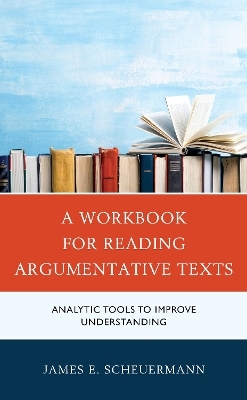
A Workbook for Reading Argumentative Texts
Rowman & Littlefield (Verlag)
978-1-4758-6473-1 (ISBN)
This Workbook is a collection of exercises and case studies designed to serve as a companion to Reading Argumentative Texts: Analytic Tools to Improve Understanding. The exercises and case studies track each of the chapters of Reading and provide opportunities for students to hone their skills at using the analytic tools presented in Reading, and to acquire additional analytic tools and concepts. These tools are illustrated through the analysis of complete essays from the mass media, speeches, a sermon, and passages from academic works.
The approach is flexible and practical and avoids academic jargon and specific theories of argumentation. As is the case with Reading, this Workbook is grounded in two principles. First, that the meaning of an argumentative text is to be found in the statements that constitute the argument itself, in other statements that are more or less directly related to the argument, and in the structure and context of the text. Accordingly, while this book discusses the analysis of arguments, argument-types, and errors in argumentation (fallacies), it focuses equally on the other sources of meaning of a text. Second, there is no single, authoritative reading of an argumentative text.
The interplay of these two premises informs the view that analyzing and understanding an argumentative text is an art and that, within certain well-defined parameters, there are “better” and “worse” readings of a text and not “right” or “wrong” readings.
The principal sources of meaning discussed include: (1) the structure of the text (and so the book examines six types of introductions and teaches how to outline and summarize), (2) key sentences, phrases, and words in a text (so the book discusses ambiguity, the difference between factual and normative statements, irony, and rhetoric), (3) context (intellectual, social, political, cultural, and physical context), and (4) the logical connections between terms in an argument (including the four different types of arguments, fallacies, and the distinction between necessary and sufficient conditions).
The book is designed to be used in late high school or early college critical reading, critical thinking, rhetoric, or writing courses.
James E. Scheuermann received his Ph.D. (in philosophy) from the University of Chicago and his J.D. from the University of Pittsburgh School of Law. For more than 40 years, as a high school and college teacher and lawyer, he has been analyzing argumentative texts for his students and professional colleagues. He is the author of numerous articles in scholarly philosophy journals and law reviews, and in other legal publications.
Preface
Chapter 1. Introduction
Chapter 2. Reading Is Not a Spectator Sport
Chapter 3. Why Are You Reading?
Chapter 4. Arguments: A Closer Look
Chapter 5. Every Person Has a Skeleton, Every Argument Has a Structure
Chapter 6. What Does the Skeleton Look Like? Outlines and Summaries
Chapter 7. Ambiguity and Nonliteral Uses of Language
Chapter 8. Context Imparts Meaning
Chapter 9. The ABC’s of Logic
Appendix I. Answer Key
Appendix II. Ramya Vijaya, Refugees don’t undermine the US economy—they energize it.
Appendix III. William Deresiewicz, The Disadvantages of an Elite Education
Appendix IV. Carl J. Asszony, True meaning of July 4 is sacrifice
Appendix V. Martin Luther King, Jr., Antidotes for fear
Appendix VI. Trevor Burrus, It’s Time to End Any Level of Federal Marijuana Prohibition
| Erscheinungsdatum | 14.03.2022 |
|---|---|
| Verlagsort | Lanham, MD |
| Sprache | englisch |
| Maße | 161 x 226 mm |
| Gewicht | 408 g |
| Themenwelt | Schulbuch / Wörterbuch |
| Sozialwissenschaften ► Pädagogik | |
| ISBN-10 | 1-4758-6473-6 / 1475864736 |
| ISBN-13 | 978-1-4758-6473-1 / 9781475864731 |
| Zustand | Neuware |
| Haben Sie eine Frage zum Produkt? |
aus dem Bereich


